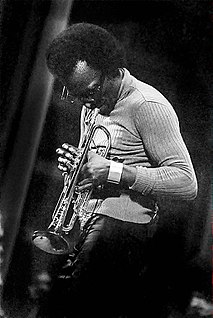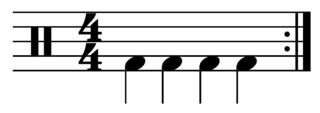Related Research Articles

Dance is a performing art form consisting of purposefully selected sequences of human movement. This movement has aesthetic and symbolic value, and is acknowledged as dance by performers and observers within a particular culture. Dance can be categorized and described by its choreography, by its repertoire of movements, or by its historical period or place of origin.
Funk is a music genre that originated in African-American communities in the mid-1960s when musicians created a rhythmic, danceable new form of music through a mixture of soul music, jazz, and rhythm and blues (R&B). Funk de-emphasizes melody and chord progressions and focuses on a strong rhythmic groove of a bassline played by an electric bassist and a drum part played by a drummer, often at slower tempos than other popular music. Like much of African-inspired music, funk typically consists of a complex groove with rhythm instruments playing interlocking grooves that create a "hypnotic" and "danceable" feel. Funk uses the same richly colored extended chords found in bebop jazz, such as minor chords with added sevenths and elevenths, or dominant seventh chords with altered ninths and thirteenths.
Jazz is a music genre that originated in the African-American communities of New Orleans, United States in the late 19th and early 20th centuries, with its roots in blues and ragtime. Since the 1920s Jazz Age, it has been recognized as a major form of musical expression in traditional and popular music, linked by the common bonds of African-American and European-American musical parentage. Jazz is characterized by swing and blue notes, call and response vocals, polyrhythms and improvisation. Jazz has roots in West African cultural and musical expression, and in African-American music traditions.
Rhythm and blues, abbreviated as R&B, is a genre of popular music that originated in African American communities in the 1940s. The term was originally used by record companies to describe recordings marketed predominantly to urban African Americans, at a time when "urbane, rocking, jazz based music with a heavy, insistent beat" was becoming more popular. In the commercial rhythm and blues music typical of the 1950s through the 1970s, the bands usually consisted of piano, one or two guitars, bass, drums, one or more saxophones, and sometimes background vocalists. R&B lyrical themes often encapsulate the African-American experience of pain and the quest for freedom and joy, as well as triumphs and failures in terms of relationships, economics, and aspirations.

In music performances, rhythm guitar is a technique and role that performs a combination of two functions: to provide all or part of the rhythmic pulse in conjunction with other instruments from the rhythm section ; and to provide all or part of the harmony, i.e. the chords from a song's chord progression, where a chord is a group of notes played together. Therefore, the basic technique of rhythm guitar is to hold down a series of chords with the fretting hand while strumming or fingerpicking rhythmically with the other hand. More developed rhythm techniques include arpeggios, damping, riffs, chord solos, and complex strums.
The music of Latin America refers to music originating from Latin America, namely the Romance-speaking countries and territories of the Americas and the Caribbean south of the United States. Latin American music also incorporates African music from slaves who were transported to the Americas by European settlers as well as music from the indigenous peoples of the Americas. Due to its highly syncretic nature, Latin American music encompasses a wide variety of styles, including influential genres such as cumbia, bachata, bossa nova, merengue, rumba, salsa, samba, son, and tango. During the 20th century, many styles were influenced by the music of the United States giving rise to genres such as Latin pop, rock, jazz, hip hop, and reggaeton.
Soul music is a popular music genre that originated in the African American community throughout the United States in the 1950s and early 1960s. It combines elements of African-American gospel music, rhythm and blues and jazz. Soul music became popular for dancing and listening in the United States, where record labels such as Motown, Atlantic and Stax were influential during the Civil Rights Movement. Soul also became popular around the world, directly influencing rock music and the music of Africa.

Jazz fusion is a music genre that developed in the late 1960s when musicians combined jazz harmony and improvisation with rock music, funk, and rhythm and blues. Electric guitars, amplifiers, and keyboards that were popular in rock and roll started to be used by jazz musicians, particularly those who had grown up listening to rock and roll.
Downtempo is a genre of electronic music similar to ambient music, but with a greater emphasis on beats and a less "earthy" sound than trip hop.
New jack swing or swingbeat is a fusion genre spearheaded by Teddy Riley and Bernard Belle that was popular from the mid-1980s to mid-1990s. Its influence, along with hip hop, seeped into pop culture and was the definitive sound of the inventive New York club scene. It fuses the rhythms, samples, and production techniques of hip hop and dance-pop with the urban contemporary sound of R&B. The new jack swing style developed as many previous music styles did, by combining elements of older styles with newer sensibilities. It used R&B style vocals sung over hip hop and dance-pop style influenced instrumentation. The sound of new jack swing comes from the hip hop "swing" beats created by drum machine, and hardware samplers, which were popular during the Golden Age of Hip Hop, with contemporary R&B style singing.

In music and music theory, the beat is the basic unit of time, the pulse, of the mensural level. The beat is often defined as the rhythm listeners would tap their toes to when listening to a piece of music, or the numbers a musician counts while performing, though in practice this may be technically incorrect. In popular use, beat can refer to a variety of related concepts, including pulse, tempo, meter, specific rhythms, and groove.

A music video game, also commonly known as a music game, is a video game where the gameplay is meaningfully and often almost entirely oriented around the player's interactions with a musical score or individual songs. Music video games may take a variety of forms and are often grouped with puzzle games due to their common use of "rhythmically generated puzzles".
Blues rock is a fusion genre combining elements of blues and rock. It is mostly an electric ensemble-style music with instrumentation similar to electric blues and rock: electric guitar, electric bass guitar, and drums, sometimes with keyboards and harmonica. From its beginnings in the early to mid-1960s, blues rock has gone through several stylistic shifts and along the way it inspired and influenced hard rock, Southern rock, and early heavy metal. Blues rock continues to be an influence in the 2020s, with performances and recordings by popular artists.

A rhythm section is a group of musicians within a music ensemble or band that provides the underlying rhythm, harmony and pulse of the accompaniment, providing a rhythmic and harmonic reference and "beat" for the rest of the band. The rhythm section is often contrasted with the roles of other musicians in the band, such as the lead guitarist or lead vocals whose primary job is to carry the melody.

Four-on-the-floor is a rhythm pattern used primarily in disco and electronic dance music. It is a steady, uniformly accented beat in 4/4 time in which the bass drum is hit on every beat in common time. This was popularized in the disco music of the 1970s and the term four-on-the-floor was widely used in that era: it originated with the pedal-operated, drum-kit bass drum. Earl Young is seen as the inventor of the disco style of rock drumming, as he was the first to make extensive and distinctive use of the hi-hat cymbal throughout the playing time of an R&B recording.
Urban Pasifika is a subgenre of hip hop which combines American style hip hop or R&B rhyming and beats with Pacific Island or Māori instrumentation and Pacific Island or Māori language singing/rapping.
Marrabenta is a popular style of Mozambican dance music combining traditional Mozambican dance rhythms with Portuguese folk music. It was developed in Maputo, the capital city of Mozambique, during the 1930s and 1940s.
This article includes an overview of the major events and trends in popular music in the 1950s.
Dixieland, sometimes referred to as hot jazz or traditional jazz, is a style of jazz based on the music that developed in New Orleans at the start of the 20th century.
References
- De Ledesma; Charles and Gene Scaramuzzo (2000). "Dance-Funk Creole-Style". In Broughton, Simon; Ellingham, Mark; McConnachie, James; Duane, Orla (eds.). World Music, Vol. 2: Latin & North America, Caribbean, India, Asia and Pacific. Rough Guides. pp. 289–303. ISBN 1-85828-636-0.
| This article about a music genre is a stub. You can help Wikipedia by expanding it. |